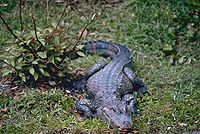
Photo from wikipedia
Critically endangered species are usually restricted to small and isolated populations. High inbreeding without gene flow among populations further aggravates their threatened condition and reduces the likelihood of their long‐term… Click to show full abstract
Critically endangered species are usually restricted to small and isolated populations. High inbreeding without gene flow among populations further aggravates their threatened condition and reduces the likelihood of their long‐term survival. Chinese alligator (Alligator sinensis) is one of the most endangered crocodiles in the world and has experienced a continuous decline over the past c. 1 million years. In order to identify the genetic status of the remaining populations and aid conservation efforts, we assembled the first high‐quality chromosome‐level genome of Chinese alligator and explored the genomic characteristics of three extant breeding populations. Our analyses revealed the existence of at least three genetically distinct populations, comprising two breeding populations in China (Changxing and Xuancheng) and one breeding population in an American wildlife refuge. The American population does not belong to the last two populations of its native range (Xuancheng and Changxing), thus representing genetic diversity extinct in the wild and provides future opportunities for genetic rescue. Moreover, the effective population size of these three populations has been continuously declining over the past 20 ka. Consistent with this decline, the species shows extremely low genetic diversity, a large proportion of long runs of homozygous fragments, and mutational load across the genome. Finally, to provide genomic insights for future breeding management and conservation, we assessed the feasibility of mixing extant populations based on the likelihood of introducing new deleterious alleles and signatures of local adaptation. Overall, this study provides a valuable genomic resource and important genomic insights into the ecology, evolution, and conservation of critically endangered alligators.
Journal Title: Molecular Ecology Resources
Year Published: 2022
Link to full text (if available)
Share on Social Media: Sign Up to like & get
recommendations!